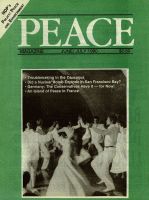
Peace Magazine Jun-Jul 1990, page 12. Some rights reserved.
Search for other articles by Diana Chown here
CANADA'S CHEMICAL and biological warfare (CBW) research takes place at the Defense Research Establishment Suffield (0RES), near Medicine Hat. Since 1986, increased public and political pressure has resulted in the government revealing some of its activities in CBW research at DRES. In 1987 it was discovered that large amounts of chemical weapons (nerve gas) had been released into the atmosphere at DRES as part of research activities. A chemistry professor from the University of Alberta has stated that such releases posed a health risk to Albertans in the vicinity of the base and possibly further. In these tests, six vials, each containing 250 mL of nerve poison were detonated, thereby dispersing the substances into the atmosphere in the form of a gas. Amounts released (1.5
Kilos) provide lethal doses for 10,000 people. There was no systematic effective monitoring of the surrounding area or nearby communities.
Two years ago, public and political criticism of activities at DRES resulted in the DND's commissioning of what has become known as the Barton Report, which revealed that 18 tons of chemical warfare agents were housed on the base. At the time of the release of the report the Defense Minister made two significant announcements: first, that this material was to be destroyed, and second, that a high security "containment facility" was to be built at the base.
One of the means of destruction will be incineration. Recently, the DND went ahead and hired a firm to build the incinerator capable of destroying chemical warfare agents. DND has apparently undertaken an initial environmental screening of the incineration process in accordance with the Environmental Assessment and Review Process (EARP) guidelines. The screening apparently found the potential impacts to be "insignificant or mitigable." However a coalition of peace and environmental groups including the Voice of Women, Project Ploughshares, the Canadian Physicians for the Prevention of Nuclear War, and the Environmental Resource Center, is not convinced that potential impacts from the incinerator are mitigable. They are pressuring the government to refer the proposal to the Minister of Environment for a public review by panel.
DND's "large-scale containment facility" will be classified as BIA (BioSafety Level 4), which is the top security classification for CBW research. Scientists at Suffield could be allowed to test the most dangerous types of pathogens in aerosol form. These include genetically altered organisms for which there is no known cure.
The decision to build such a facility in Canada is likely due to rejection of the same type in the U.S. In 1988, public and political pressure successfully defeated the construction of a BM containment facility near Salt Lake City, Utah. This defeat was due to the U.S. Department of Defense being cornpelled to allow public hearings on their draft Environmental Impact Statement for the facility. The outcome was that the U.S. Army backed away from its plan to build a BM facility and downgraded to B12 which, according to the New York Times (20 Sept, 1988), "would preclude tests using genetically altered microbes or lethal diseases for which there are no cures."
It seems less than coincidental that the defeat of the BM containment facility in Utah and the announcement in Canada that such a facility was to be built here both took place about the same time. This suggests that the U.S. military, having bowed to pressure in the U.S. and withdrawn its plans to build a BM containment facility in Utah, has convinced its northern partner to build the facility in Canada.
The Defense Minister has stated that projects such as the containment facility will be "subject to the governmental Environmental Assessment and Review Process." We must show there is public concern and that a public review by panel must be part of the DND's EARP for the facility. At a time when the need for defense establishments is dwindling, a high level security containment facility for CBW research, defected in Utah and now being proposed for Canada, must not be built in Alberta. For more information contact:
Diana Chown, 10935-85th Ave., Edmonton, AB. T6G 0W3 Ph: 433-1525 or South East Alberta Coalition for the Environment, Box 16, Site 2, RR #1, Irvine, AB TOJ iVO Ph: 893-2226.

Peace Magazine Jun-Jul 1990, page 12. Some rights reserved.
Search for other articles by Diana Chown here